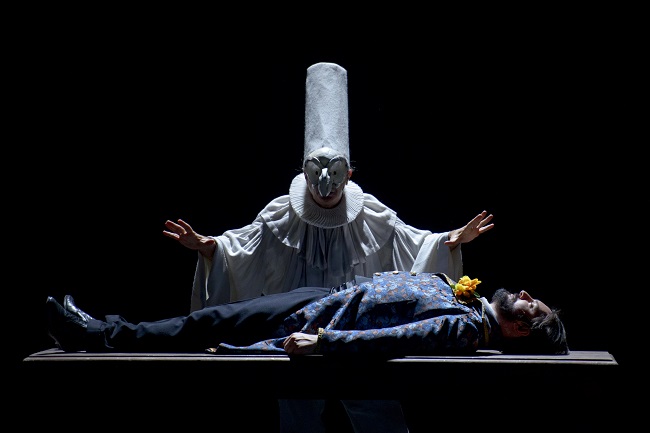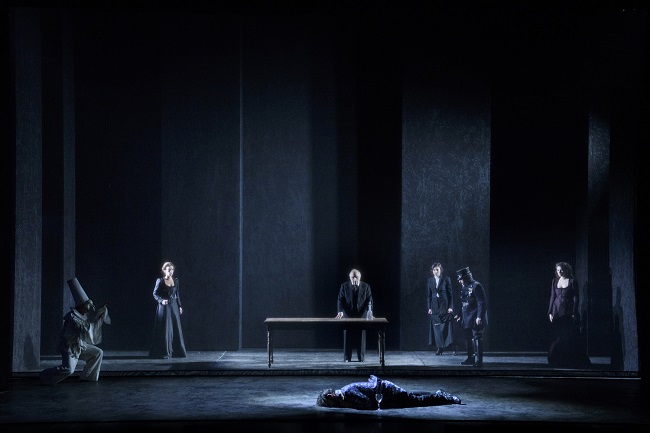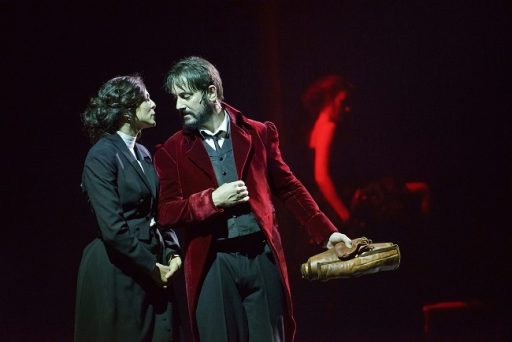Recensione di Isabella Rossiello
“I due gemelli veneziani” di Carlo Goldoni, scritta nel 1747, commedia in tre atti che però il regista, Valter Malosti, con l’adattamento di Angela Demattè, non interrompe, e a ragione, perché il plot è coinvolgente, intricato, un thriller che concede tante risate.
Trama:
Il Dottor Balanzoni ha una figlia, Rosaura, che vuole dare in sposa al ricco ma sciocco Zanetto cresciuto a Bergamo e ignaro di avere un fratello gemello, brillante, dongiovanni, cioè Tonino, furbo viveur che vive a Venezia.

A casa dei Balanzoni vive Colombina, serva intrigante che minaccia sempre di rivelare un segreto riguardante Rosaura e suo padre.
Il caso vuole che nello stesso periodo anche Tonino si trovi a Verona e qui comincia l’intrigo, la commedia, il dramma.
Tonino deve incontrare la bella Beatrice insidiata da Lelio, nipote di Balanzoni, e affidata a Florindo, che ne è innamorato.
Data la somiglianza dei due gemelli, accade di tutto, loro sono continuamente scambiati in ruoli che non competono a nessuno dei due e nel momento sbagliato.
Ruolo quasi dominante, però, è quello di Pancrazio, amico “fidato” del dottor Balanzoni, che invece è causa di grande disgrazia.
Innamorato di Rosaura, convince il debole Zanetto a credere che le donne siano “streghe” capaci di ogni nefandezza fino a convincerlo a farsi prete.
L’amore per Rosaura però è più forte e lui ne è davvero innamorato; accecato dalla gelosia, Pancrazio avvelena Zanetto.
La polizia cerca il colpevole, ma è il sagace Tonino a scoprire tragicamente il colpevole e contemporaneamente che lì c’è il cadavere di suo fratello gemello. Colombina poi rivela un altro tragico segreto: Rosaura non è figlia di Balanzoni ed è sorella dei due gemelli. Ormai scoperto, l’assassino Pancrazio si uccide con lo stesso veleno.
Un colpo di scena che incanta, stupisce, e il pubblico applaude.
Sipario.

La regia di Walter Malosti è intrisa di più culture e la scenografia scelta è essenziale, minimalista, tanto nero e luci saggiamente dosate, musica elettronica in sottofondo; il clou sono gli attori, il palco, l’attenzione è solo per loro, quasi ipnotica.
Non è il “solito” Goldoni ricco di frizzi e lazzi ma un Goldoni quasi shakespeariano ed è lo stesso Malosti nella brochure di presentazione a citare autori fondamentali nella costruzione delle “lingue italiane” da Pasolini a Gadda, perché in effetti un Pulcinella birichino parla in napoletano e unisce Verona a Napoli.
Gli attori che hanno contribuito a questo successo:
Zanetto\Tonino: Marco Foschi
Pancrazio: Danilo Nigrelli
Arlecchino\Pulcinella: Marco Manchisi
Beatrice: Irene Petris
Il dottor Balanzoni : Alessandro Bressanello
Rosaura: Anna Gamba
Brighella\Bargello: Valerio Mazzuccato
Colombina: Camilla Nigro
Florindo: Vittorio Camarota
Lelio\Facchino: Andrea Bellacicco
Le scene e le luci sono di Nicolas Bovey
I costumi di Gianluca Sbicca
Il progetto sonoro a cura di GUP Alcaro
Cura del movimento Marco Angelilli.
Si ringrazia ERT, l’Ufficio stampa del Teatro Bonci di Cesena e la sua preziosa organizzazione.
Review by Isabella Rossiello
“I due gemelli veneziani” by Carlo Goldoni, written in 1747, is a comedy in three acts directed by Valter Malosti with the adaptation by Angela Demattè. Being that it was performed in a single act, there were not any interruptions, and rightly so, because the plot is engaging, and intricate, a thriller that gives many laughs.
Plot:
Doctor Balanzoni has a daughter, Rosaura, who he wants to marry to the rich but foolish Zanetto, raised in Bergamo and unaware of having a twin brother, Tonino, a brilliant Don Juan, and clever viveur who lives in Venice. At the Balanzoni house lives also Colombina, an intriguing servant who always threatens to reveal a secret about Rosaura and her father.
As chance would have it, in the same period Tonino was also in Verona, and here began the intrigue, the comedy, the drama.
Tonino must meet the beautiful Beatrice, threatened by Lelio, Balanzoni’s nephew, and entrusted to Florindo, who is in love with her.
Given the similarity of the twins, everything happens, they are constantly exchanged in roles that do not compete with either of them and always at the wrong time.
An almost dominant role, however, is that of Pancrazio, a “trusted” friend of Dr. Balanzoni, who instead is the cause of great misfortune.
In love with Rosaura, he convinces the weak Zanetto to believe that women are “witches” capable of any wickedness, to the point of convincing him to become a priest.
The love for Rosaura, however, is stronger, and he is really in love with her; blinded by jealousy, Pancrazio poisons Zanetto.
The police are looking for the culprit, but it is the shrewd Tonino who tragically discovers the offender and at the same time that there is the corpse of his twin brother. Colombina then reveals another tragic secret: Rosaura is not Balanzoni’s daughter, and she is the sister of the twins. Discovered, the murderer Pancrazio kills himself with the same poison.
A twist that enchants, amazes, and the audience applauds.
Curtain.
Walter Malosti’s direction is imbued with multiple cultures and the chosen scenography is essential, and minimalist, with lots of black and wisely dosed lights, and electronic music in the background. The highlights are the actors and the stage; the attention is only on them, almost hypnotic.
It is not the “usual” Goldoni full of frizz and lazzi but an almost Shakespearean Goldoni and it is Malosti himself in the presentation brochure to cite fundamental authors in the construction of “Italian languages” from Pasolini to Gadda, because, in fact, a mischievous Pulcinella speaks in Neapolitan and unites Verona to Naples.
The actors who have contributed to this success:
Zanetto\Tonino: Marco Foschi
Pancrazio: Danilo Nigrelli
Harlequin\Pulcinella: Marco Manchisi
Beatrice: Irene Petris
Dr. Balanzoni : Alessandro Bressanello
Rosaura: Anna Gamba
Brighella\Bargello: Valerio Mazzuccato
Colombina: Camilla Nigro
Florindo: Vittorio Camarota
Lelio\Porter: Andrea Bellacicco
The sets and lighting are by Nicolas Bovey
The costumes of Gianluca Sbicca
The sound project by GUP Alcaro
Stage director: Marco Angelilli.
We thank ERT, the Press Office of the Teatro Bonci in Cesena and its precious organization.


